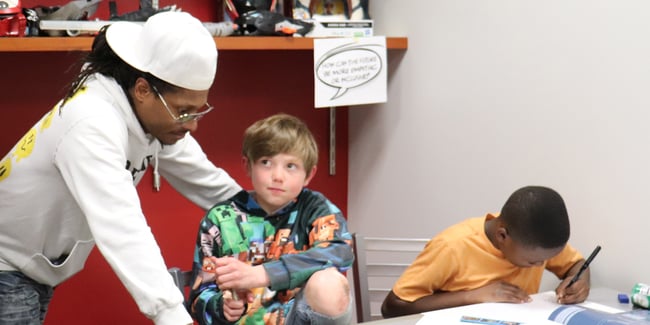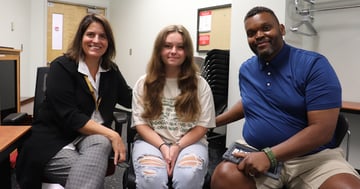All students benefit from the structure, mentoring and connections that out-of-school time offers. Academic improvement, enhanced social, emotional and leadership development, along with mentoring experiences, become possible for Central Minnesota students through out-of-school time opportunities—and that’s especially important for kids who may not always have access to programs or enrichment activities because of systemic barriers and inequities.
Otis Morris, dean of students at St. Cloud Area Schools, understands the significance of out-of-school time support. Balancing practices, games and schoolwork challenges all middle schoolers. When a student struggles with that balance, out-of-school time support can mean the difference between being able to participate in an activity or sitting on the sidelines.
One instance of this stands out in Morris’ memory. A seventh-grade student loved the game of basketball and was a tenacious and hardworking player. Yet, academic work often felt challenging for him. The athletic coordinator began serving him eligibility forms and informed him that he needed to get his grades up to continue to play the game as a school activity. He was failing six of his classes.
The student sought out-of-school time homework help funded by United Way of Central Minnesota. He began to channel the same drive he had on the court to improve his academic work. With the help of staff, he began using new tactics to manage his time and responsibilities more efficiently. The quality of his schoolwork steadily improved. By the end of the season, he passed all six of the classes he was previously failing.
Morris says this student’s success was possible because he worked hard and could access resources outside the typical school day, giving him the boost he needed to reach his potential. “We are very thankful for partners like United Way that help pay our determined staff to support students academically, socially and emotionally.”
United Way of Central Minnesota works with at least 17 local out-of-school time sites to provide support that enhances programming at locations where underserved young people and those experiencing economic instability live and go to school.
New Spaces, New Skills
Out-of-school time is any time students spend outside the classroom and during an academic day, and can occur in many places and spaces. UWCM’s Out-of-School Partnerships Program Coordinator, Andrew Small, says out-of-school time is more than two hours after school and could include time before school, during the weekends and summertime. “It’s when young people are home with their family, too. It’s more than time directly after the school day when kids need care. Although homework help may be important, it also involves more than just academic support. The outcomes programs have go beyond improving reading and math skills. Participants have a variety of experiences that help them grow and develop.”
Clarinda Solberg, director of out-of-school time partnerships, says that when young people have access to summer camps and enrichment programs, there is measurable positive impact on them and the community. “Young people make new connections and gain skills that they can bring forward into how they show up for the rest of their lives. They engage in leadership and decision-making that helps them become more engaged in where they live.”
UWCM’s Out-of-School Time Evaluation and Reporting Manager Jennifer Jimenez-Wheatley says that out-of-school time programming is a powerful tool in leveling some of the disparities students may experience in learning environments. “Out-of-school time allows kids to work with their peers in ways that may not be available in the classroom. These interactions narrow those gaps, and young people can develop trusting relationships with adults, too. Building those relationships feels less high stakes for them, so they can grow in confidence and explore their interests.”
Jerica Anderson, United Way’s out-of-school partnerships manager, adds: “This kind of programming is a way for young people to be exposed to new experiences and explore their interests within their own communities.”
A Shared Vision of Success
UWCM has long recognized the importance of out-of-school time as vital to leveraging student potential. In 2017, Partner for Student Success, made of diverse community members, came together to develop a shared vision of what success might look for all students in Central Minnesota. This group aimed to address educational and economic disparities and bolster the area’s student outcomes. With this vision, the group hired the Search Institute to develop a strategic plan. They, in partnership with two school districts, applied for the first Nita M. Lowey 21st Century Community Learning Centers grant (21CCLC) to give local students enrichment opportunities during nonschool hours through school- and community-based out-of-school time centers. The 21CCLC Cohort 8 grant serves kindergarten through grade eight students, and Cohort 9 serves students in grades six through 12.
Anderson explains that Cohort 9 works with more school-based centers. “Our work in those locations is about meeting students where they already are developmentally. We focus a lot on experiences that are designed to help students become college- and career-ready.”
Small points out that all of the work supports programming that is attuned to what is most required at a specific site. “This funding for programs is very directed towards the needs of students in those specific locations.”
Solberg says both cohorts work together to expand opportunities for community partnerships. “These grants work to stimulate collaboration and co-learning between out-of-school time and the school day in ways that can powerfully support young people in our community with essential skills like literacy.”
Empowering Programs to Discover What’s Possible
United Way “helps the helpers” and does much more than simply act as agency funders. UWCM’s Out-of-School Time Partnerships team tries to emphasize the partnerships part of their title. They often act as sounding boards for directors and specialists as they plan and implement programs. They provide data collection and train professionals to use an evaluative approach in their work. They strategize alongside partners to actively engage youth, build skills and provide connections, resources and tools that refine programs. Most importantly, UWCM’s out-of-school time team helps partners identify the shared goals they have with other youth-serving organizations and facilitate collaboration within the community.
“We are coordinated with a network of professionals and community members and are positioned to invest resources into out-of-school time organizations. We can provide aligned professional development opportunities and share data so organizations are able to continue to provide kids and families with great service and give more access to enrichment opportunities in our community. That’s the benefit of our network,” says Solberg.
Investing in Kids and Community
She goes on to explain why out-of-school time matters to Central Minnesota: “Quality programming includes practices that create safe physical environments, but also emotionally supportive environments that give kids the chance to engage with their peers and make decisions alongside the adults caring for them. They build confidence and gain new skills by trying things, making mistakes and learning from those to try again and grow as humans. We stand by programs that do that work every day and support them in that.”
Anderson nods in agreement and adds that for her, support for out-of-school time is ultimately an investment in the future. “Out-of-school time is just a beautiful opportunity for us to continue pouring into the next generation. It’s a way for young people to grow in our community.”
.jpg)



